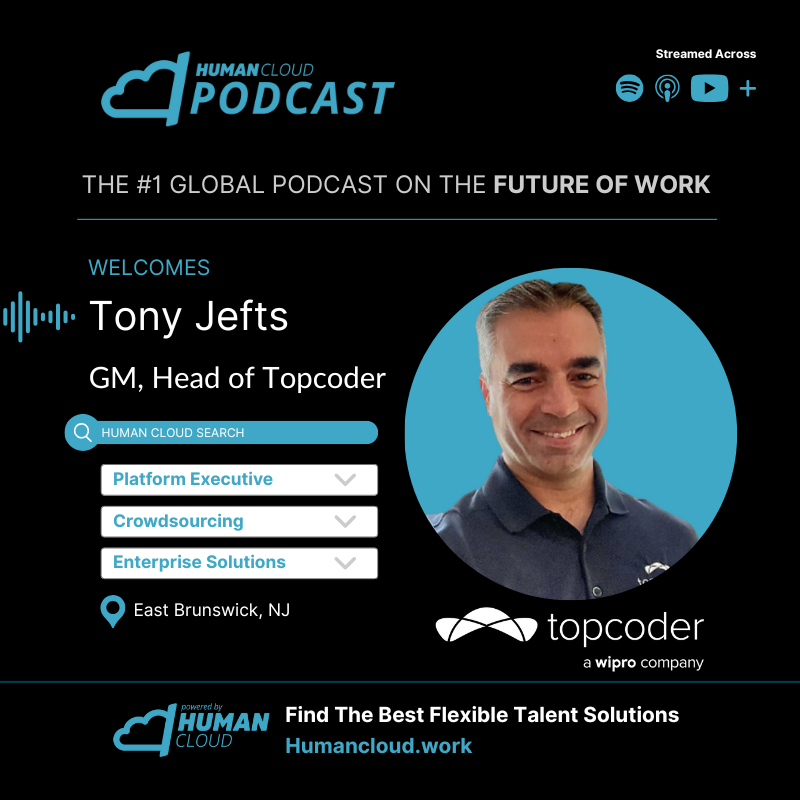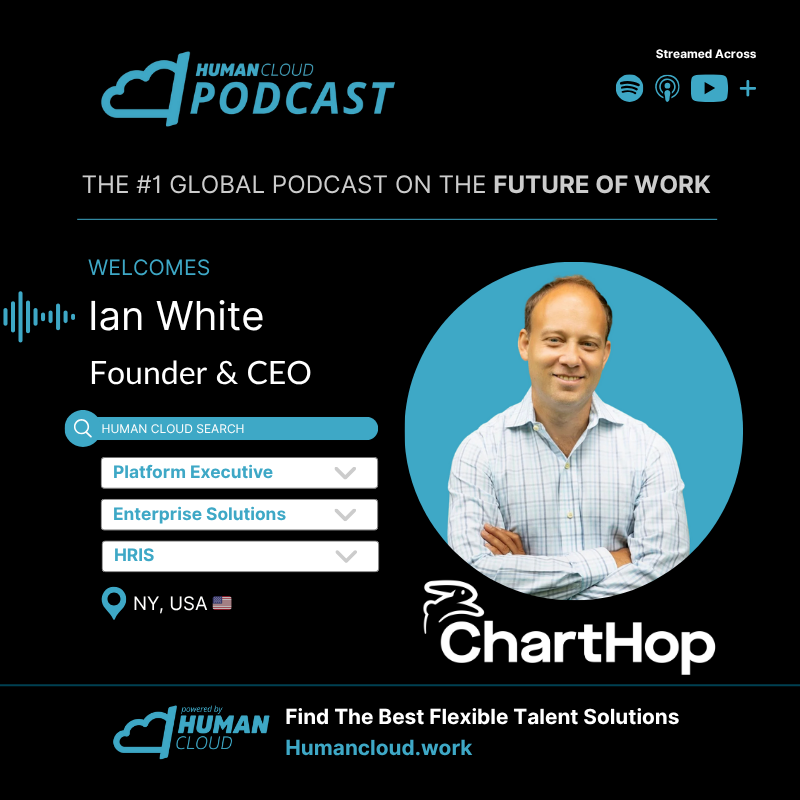
Jeff Fenigstein, Founder of Market Growth, Former Woodruff Sawyer
Subscribe to Human Cloud Podcast
Leaders,
We all know Enterprise adoption is the biggest barrier facing the freelance economy today. While freelance as a talent source is globally recognized, we’re still in the first inning of the maturity of freelance as an industry. Unlike Uber or other B2C based startups, freelance as an industry looks more like a B2B professional service transformation than a venture backed technology industry. The impact is that instead of overnight adoption, industry maturity is a long, mostly linear process.
Which is why today’s guest is so perfect.
Jeff Fenigstein has scaled marketing freelancers across marketing teams for large companies, first at Woodruff Sawyer, and now as the founder of Market Growth. Specifically, Jeff knows how freelance can be a strategic sourcing strategy that creates dream teams rather than looking at freelancers as transactional contractors that “plug a hole” or “fill a gap”.
In this episode, we’ll get into why Jeff turned to freelance, what his use cases were, and how he overcame the organizational bureaucracy that stands in the way of so many freelance leaders. He also shares his experiences with freelance adoption in different environments, such as startups and enterprise organizations.
Jeff emphasizes the need for internal champions and effective communication to overcome hurdles and successfully integrate freelancers into an enterprise. He recommends that enterprise leaders explore freelance platforms, try small projects, and educate themselves on the benefits and possibilities of freelance work.
Key takeaways:
- Freelancers can help businesses accomplish more and reach their goals by providing specific skills and capacity when needed.
- Using freelance platforms offers access to top talent, faster hiring processes, and the ability to try before committing to a long-term hire.
- Freelance adoption is different depending on the environments, such as startups and enterprise organizations.
- In the Enterprise, freelance adoption requires internal champions and effective communication.
- To get started, Enterprise leaders should try small projects.
Chapters
00:00 – Introduction and Background
03:16 – Why Should Business Leaders Care About Freelancers?
05:33 – Why Choose Freelance Platforms Over Other Options?
09:33 – The Range of Freelance Opportunities
10:33 – Rethinking Unicorns
13:14 – Different Environments for Freelance Adoption
21:34 – Overcoming Hurdles in Enterprise Adoption
25:00 – Myths and Realities of Freelance Platforms
29:39 – Big Wins and Disruption with Freelance
35:15 – Recommendations for Enterprise Leaders
38:23 – Conclusion and Contact Information
Follow Up Material & Links
Favorite Quotes
Why do companies need freelance?
- “You know, I could talk about, and we can, the cost savings and the capacity and those aspects, but if we’re really going to hit the why, for me, I believe that people genuinely want to accomplish more. They want to do bigger things. They want to hit their goals. It’s not about doing less. I think perhaps there’s leaders who think, well, no, I’m paying these people to do this job. I’m paying the marketing person to run marketing. I’m paying the social media person to do social media. Why would I hire a freelancer? Like that’s their job. They should know how to do it and just get it done. But none of our roles, whether you’re the head of marketing or just the email marketing person, it’s not one thing. There’s a lot of aspects to it and you don’t always have the skills or the capacity to hit the goals at that time. And I think if leaders think about it in terms of what needs to get done and stop drawing this definitive line between full-time employee and freelancer, it opens up a new view on how to accomplish the goals.”
What’s an example of a big win?
- “I think it’s the, I think it’s the small wins that really add up to the big wins. It’s, it’s those places where, so for instance, the, one of the teams outside of marketing every year, they had a big need for design services. So this was the employee benefits team.
- As we all know, come fourth quarter, you all get those packets, the open enrollment, and it’s all laid out and it tells you like, here’s your benefits for the year and all the great things we offer. Well, those all have to be designed. And that was really hard to staff for on the marketing team because it was just huge. I mean, every client needed these and they’re all different because it’s, you know, it has your company’s logo and everyone’s, everyone’s offerings, healthcare offerings are different. So it’s not like make one and give it to all the clients.
- So all of a sudden, fourth quarter’s rolling around, and there’s this massive need for marketing help, and mostly design. So.
- Really problematic. Can’t just stop everything that’s going on in the marketing team, but can’t staff for that year round. Otherwise they’re gonna be sitting on their hands for nine months out of the year. And it was also a lot of back and forth for the marketing team to manage. And I worked out with the leader of that group. How about this? I’m gonna get you all the designers you need. All the capacity.
- You’re going to work with them directly, but we’re going to train them. And if someone’s not working out, we’ll address it or replace them. And you will have all the people you need to work directly with them. So they’re going to get faster serviced that it’s going to be this person’s top priority versus like, hey, the marketing team, we can get to that next week because we have another thing going on.
- I couldn’t have done that otherwise. I mean, that was the whole problem. If you had to do the full-time people, but now I had a whole service offering for my internal client. That I could do that didn’t even hit my budget and they got everything that they needed and the work got done. So it’s like, you can build these teams and that team was for three months, but we could use the same people next year as well.
- That would never happen. Full time. It wouldn’t even happen with a staffing agency because the staffing agency that probably person’s not available next year because freelance isn’t their thing. They’re probably in between in between gigs.”
What was the pushback and barriers?
- “It was interesting in early meetings to hear with legal and HR questions that were like, well, where it would be, oh, well, how are we gonna control the budget and the spend if we were to use Upwork? And thinking that it’s so different. Like, well, how do we control budget and spend right now? Because they’re like, well, if anyone can go on to the platform at the company and hire somebody, what if they don’t have budget for it? What if they’re not allowed? I’m like, well, it’s not any different than if that person is not allowed to go out and hire a staffing agency or hire somebody else who’s going to be at 1099. It’s no different.
- So there was a little bit of this having to translate.”
Powered By Human Cloud, the global authority on the freelance economy.
Human Cloud helps freelance leaders solve their toughest challenges. From Enterprises scaling freelance workforces, to Platforms positioning their unique differentiation, Human Cloud is fortunate to have a global hand in helping the freelance economy grow.
Interested in partnering with Human Cloud?
> Visit us at https://humancloud.work
> Contact us at [email protected]
> Leverage the largest database of freelance insights at https://humancloud.work/industry-insights





 This is only available to Knowledge Graph subscribers
This is only available to Knowledge Graph subscribers 